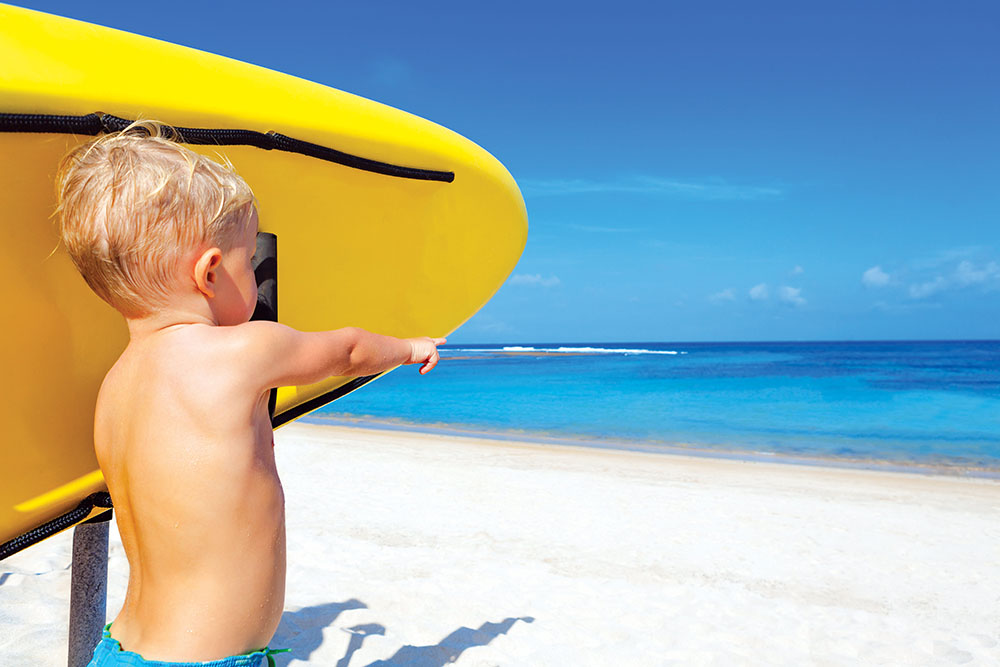By Beachsafe.org.au and lsv.com.au
We all love a day at the beach. However, the surf can be unpredictable. That’s why lifeguards put up the red and yellow flags to show you the supervised area.
Staying safe and making the most of the coast requires knowledge and skills. It’s all about helping you to enjoy our beautiful coast.
Although Australian beaches may look amazing, they can be unpredictable and hide some dangers that every visitor should be aware of. Here you will find some very helpful info and advice from lifeguards on beach safety, to ensure you enjoy your visit to the beach and stay safe!
Always swim between the red and yellow flags
When you see red and yellow flags on a beach, it indicates that there is currently a lifesaving service operating on that beach. The lifeguards have chosen a section of the beach that is best for swimming and they will closely supervise this area. Lifeguards pay more attention to the area between the red and yellow flags than any other part of the beach.
Read the safety signs
Before you go on to the beach be sure to read the safety signs. This will ensure you are aware of any warnings or dangers on the beach. You can also find other helpful information to make your day at the beach more enjoyable. You might also find single signs placed on the beach to highlight specific warnings.
Ask a lifeguard for safety advice
Lifeguards are highly trained and very knowledgeable about beach safety and conditions. When you arrive at the beach look for and identify the lifeguards. Feel free to ask them about the day’s conditions, as well any additional beach safety advice they might have for that specific beach – because every beach is different.
Swim with a friend
Not only is swimming with a friend (or family member) a fun way to enjoy the beach, it is also very sensible. While you are swimming together you can keep an eye out for each other, and if further assistance is required, one person could call or go for help. If everyone swimming together knows their own limits it is a good idea to share this with those around you so you can all stay within everyone’s comfortable limits.
If you need help, stay calm and attract attention
Even the most careful people can find themselves out of their limits in the water. If you are not feeling comfortable in the water and you require a lifeguard’s assistance to get back to shore, stay calm, raise your arm in the air and wave it from side to side. This will attract the attention of a lifeguard who will be able to come to your assistance. You should conserve your energy by floating on your back and staying calm. This will ensure you have the energy to remain afloat until further aid arrives.
Beachsafe.org.au is brought to you by Surf Life Saving Australia, sls.com.au, as part of our ongoing commitment to education and safety in the aquatic environment.
Life Saving Victoria’s mission is to prevent aquatic related death and injury. Our vision is that all communities will learn water safety, swimming and resuscitation, and be provided with safe beaches, water environments and aquatic venues. lsv.com.au
RIP CURRENTS
RIP CURRENTS ARE STRONG CURRENTS OF WATER FLOWING AWAY FROM SHORE THROUGH THE SURF ZONE. THEY ARE A STRONG FORCE AND ON ANY GIVEN DAY, THERE ARE ABOUT 17,000 RIPS AT BEACHES AROUND AUSTRALIA.
THE FACTS ABOUT RIP CURRENTS
There are many myths about the ocean. Many people think it’s just tourists and poor swimmers who get caught in rips currents. In fact, it’s young men aged 15-39 years who are most likely to die in rips. Rips are the number one hazard on Australian beaches. The best way to avoid a rip is to swim at a patrolled beach between the red and yellow flags.
HOW TO SPOT A RIP CURRENT
Rips are complex, can quickly change shape and location, and at times, are difficult to see. The things to look for are deeper, dark-coloured water; fewer breaking waves; a rippled surface surrounded by smooth waters; and anything floating out to sea or foamy, discoloured, sandy, water flowing out beyond the waves. Rips don’t always show all of these signs at once.
HOW TO SURVIVE A RIP CURRENT
Stay calm and consider your options. Raise an arm to seek help. Try floating with the current, it may bring you back to shore. Swim parallel to the shore or towards breaking waves and use them to help you in. Reassess your situation. If what you’re doing isn’t working, try one of the other options until you’re rescued or return to shore.
Beachsafe is brought to you by Surf Life Saving Australia as part of our ongoing commitment to education and safety in the aquatic environment.


